A continuation of our series of photos of the Muslim Hui community in Lhasa.

Hui Minority Market in Lhasa
Your blog to China

Tibet 西藏省: Tibet is difficult to travel around independently, we were lucky to visit during a window of relative openness in 2007; before the riots and the insuing clampdown.
The articles below are only a part of what we saw. We will be uploading more over time.
Hui Minority in Lhasa: A collection of photos depicting the Muslims living in Lhasa.
Gyantse and the Kumbum are the beating heart of Tibet and Tibetan culture.
Remoche Temple Candle Making (酥油灯; SŪYÓU DĒNG) is an incredible spectacle to behold
Sixth photo in a series of photos featuring the Muslim Hui community in Lhasa.
Photo five of the Muslim Hui community in Lhasa taken in the Muslim quarter outside the Great Mosque: Qing Zhen Da Si 清真大寺
One of Tibet`s most traditional towns. You’ll find fantastic architecture, amazing back streets and lots of cows.

Gyantse and the Kumbum are the beating heart of Tibet and Tibetan culture. We visited Gyantse on a three-day trip by mini-van that also included Shalu monastery and the town of Shigatse. We reached Gyantse after a long eight-hour ride, made even longer by our detour to see Yamdrok-Tso Lake.

From the Kamba-La Pass at 4794 metres, there are spectacular views over the turquoise waters of the lake. However, due to road works (expected to be finished next year), it wasn’t possible to continue along the old road to Gyantse, so we had to turn back and rejoin the new road.

The final part of the journey took us through fertile and idyllic fields, full of grazing animals and harvesting farmers.


The approach to Gyantse is truly spectacular: the ruins of the fortress, the Dzong, destroyed by Younghusband and his British troops, set on a steep, rocky hill, stand out against the azure sky and the golden roofs of the monastery gleam in the sun.

Gyantse itself is rather more prosaic; it is basically a scruffy one-street town (2007: has expanded now) with an interesting, traditional Tibetan quarter.
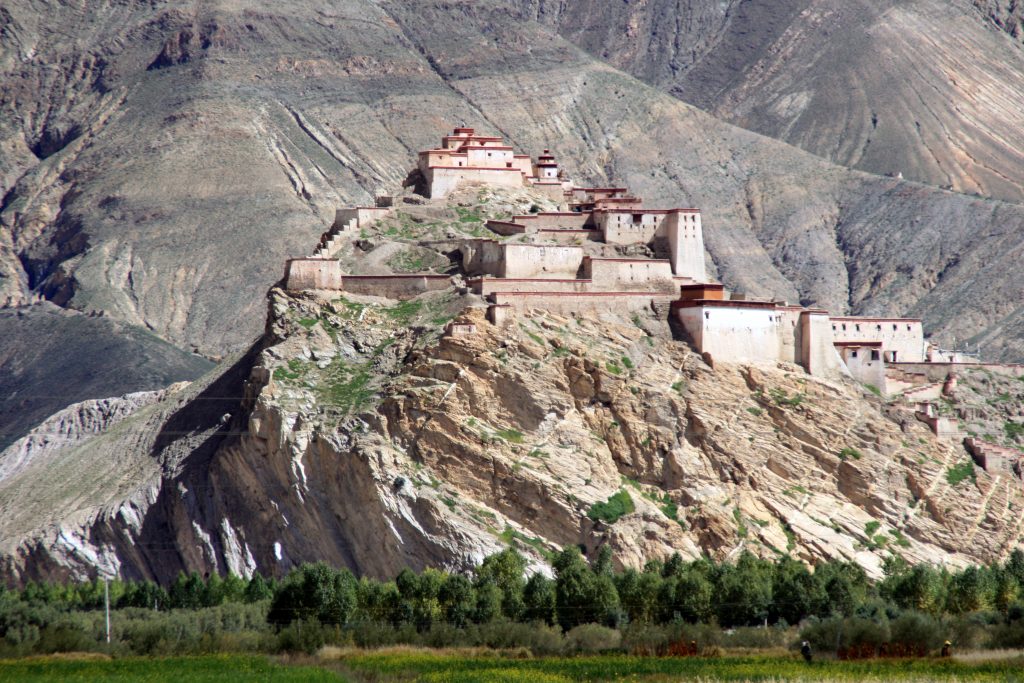
We had just enough time to visit the Pelkhor Chöde Monastery complex, situated dramatically at the foot of the barren mountains and surrounded by a brown wall.

Gyantse’s highlight is the Kumbum, an 8 storey chorten, topped by a golden roof and umbrella, apparently the best- preserved structure of this kind in Tibet.

The 8 floors contain 108 chapels, all covered in frescoes and many holding statues. The outside is painted a dazzling white and decorated with colourful stucco, as well as four huge pairs of eyes, which survey the surrounding countryside.

Though most of the frescoes are hidden in darkness and many are damaged, we managed to make out some frightening demons, adorned with necklaces of skulls, fine many-armed Buddhas and delicate maidens.

The chapels which are set at the corners are the best, as they are two storeys’ high and contain a variety of large statues.

On the sixth floor we emerged onto an open platform, level with the painted eyes, from which we could observe the other monastic buildings, the walls, the mountains, as well as the Tibetan old town.

The next day we visited the old fortress, or Dzong, and explored the Tibetan quarter.

As we mentioned before, most of the Dzong is in ruins; thanks to Younghusband and his men who came riding in from Sikkim to ‘open’ Tibet to trade… They are, however, quite atmospheric ruins. One of the highlights is a grey memorial stone with the curious inscription ‘Jump off the cliff’.

However, this isn’t an exhortation to visitors, but rather a commemoration of an act of bravery committed by the outnumbered defenders.

The old Tibetan quarter, lying at the foot of the fortress, is another gem that takes you right back in time.

Along the main street, there are placid cows chewing the cud in front of every household, while pigs and sheep rummage around in the gutters.

People gather at the communal pumps to draw water, wash their clothes, hair or rinse dyed strings of sheep’s wool.

Inside the traditional stone houses, Tibetan ladies work the heavy wooden looms to weave cloth or colourful Tibetan carpets.

A peaceful, mellow village ambience reigns and life continues, unhurriedly, as it always has done.



We stayed at the Jianzang hotel which lies on the main street of the modern part of town (Yingxiong Nanlu) and is certainly one of the nicest places we stayed at in the whole of Tibet, or even China. The hotel is embellished with bright, colourful murals and lovely potted plants and flowers, while rooms are large, clean and comfy. We paid 180 Yuan for a double with bathroom, though there were cheaper rooms and dorms as well. The hotel also has its own rooftop restaurant and staff are very friendly.

You will have no trouble finding several places to eat along the same main street. The Yak bar and restaurant, for which you have to go upstairs, is a pleasant, laid-back place with Tibetan sofas and low tables, specialising in western-style food such as chips, pizzas and burgers. There is a large Chinese restaurant, a few doors away and identified by a green sign, where we had an excellent meal.

Fourth photo in a series of photos featuring the Muslim Hui community in Lhasa.
Third photo in a series of photos featuring the Muslim Hui community in Lhasa.
Second photo in a series of photos featuring the Muslim Hui community in Lhasa.

Muslim Food Market in the old city of Lhasa
First photo in a series of photos featuring the Muslim Hui community in Lhasa.

Remoche Temple Candle Making (酥油灯; SŪYÓU DĒNG) is an incredible spectacle to behold. I doubt if much has changed since the construction of the temple in 7th Century. Below is the account of our visit in August 2007 when travelling for foreigners in Tibet was at its most relaxed in decades.
The three story Ramoche Temple (小昭寺XIǍOZHĀO SÌ), in the heart of Lhasa, just a short walking distance away from the Bakhor, is an alluring temple to visit when you are in Lhasa. So close to the hustle and bustle of modern life yet still bursting with old traditional Tibetan rites

Originally Built around the same time it’s more famous sister temple, the Jokhang temple (at some point during the Tang Dynasty), probably between 649 and 676 during the reign of Mangsong Mangsten, the Ramoche temple has been destroyed and rebuilt more than once during its turbulent history.

Your nostrils detect the oily, buttery, smell of boiling yak butter long before you actually you arrive at Ramoche. The air in and around the temple is filled with the unmistakable smell of Yak butter; it permeates everything from the walls of the temple to the clothes of the pilgrims.

During much of the day Ramoche is a hive of activity, with throngs of visiting pilgrims, the odd tourist group, resident monks, caretakers, , sand using mandala makers (The mandala represents an imaginary palace that is contemplated during meditation), and finally, the unmissable yak butter candle makers.

As you watch the yak butter makers go about their trade, there are moments when you think they are going to be entirely devoured by the soaring flames. At other times, their faces are forced to wince and scrunch up at the scorching heat and the spitting fat that leaps out of the cauldrons.

The process is non-stop; with someone always on hand to take over when a worker is flagging. Sometimes its a monk, other times it’s a care taker, and at other times pilgrims join in.
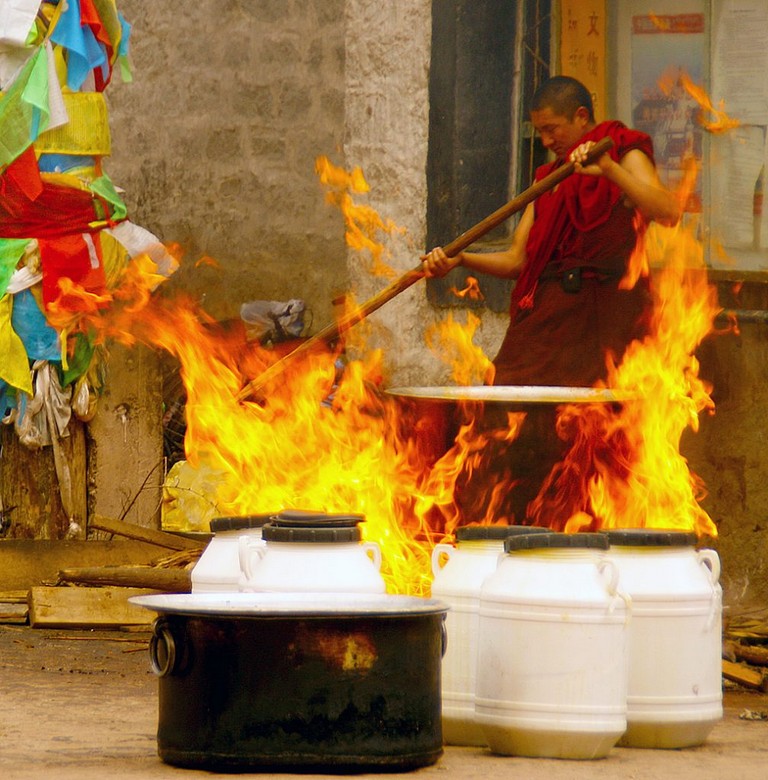
With the yak butter candles inside the temple burning almost 24/7, it’s no wonder that the butter making process is relentless and continuous.

The heat generated from the cauldrons can be felt around the main square in front of the temple. Monks and workers use enormous wooden handled ladles to stir the molten liquid and then scoop it out and pour it in to buckets for the gooey fluid to cool.

At the same time other pilgrims are adding more butter to the cauldrons. The pilgrims believe that by bring their own yak butter they will gain merit.

When the butter has cooled, it is taken inside the temple, where an army of helpers fill the empty candle holders. Like the melting process outside, cleaning and preparing the candles seems to be an around the clock activity.

As soon as a new candle is prepared, there is always a newly-arrived pilgrim ready to burn it. And so the cycle goes on.

If you are lucky, you might also catch the monks making sand mandalas 沙坛城; Shā Tánchéng .

One of Tibetan Buddhism’s most bizarre activities; the monks can spend hours, days or weeks preparing these incredibly beautiful and ornately coloured sand mandalas; only then to destroy them after a ceremony.
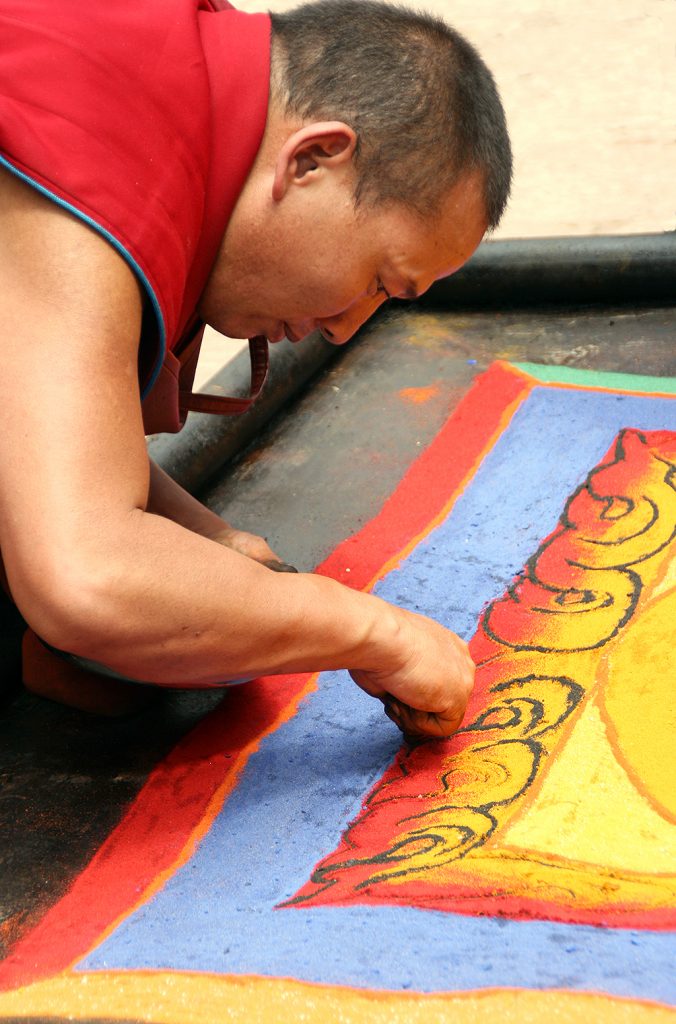
Why? To demonstrate the Buddhist belief that nothing is permanent.

For More on Tibet click here: Gyanstse and the Kumbum
This an updated version of the article and photos of Shalu Monastery that we published on the old holachina.com web-site. Since 2009 Shalu Monastery has undergone massive restoration so it may be quite different from when we were there.

The Shalu Monastery in Tibet is a fantastic example of Tibetan Culture. The murals on the walls are spectacular and the surrounding village is 100% Tibetan.
We visited the monastery of Shalu 夏鲁寺 on the second day of our excursion, as a side trip on the way from Gyantse to Shigatse. Shalu was actually off limits to foreigners and we didn’t have it listed on our permit. Our excursion was a spur of the moment decision.

However, our Tibetan driver nonchantly said there would be no problem. And hey this was 2007! Travelling in Tibet was hassle free and foreigners could drop into almost anywhere they wanted.
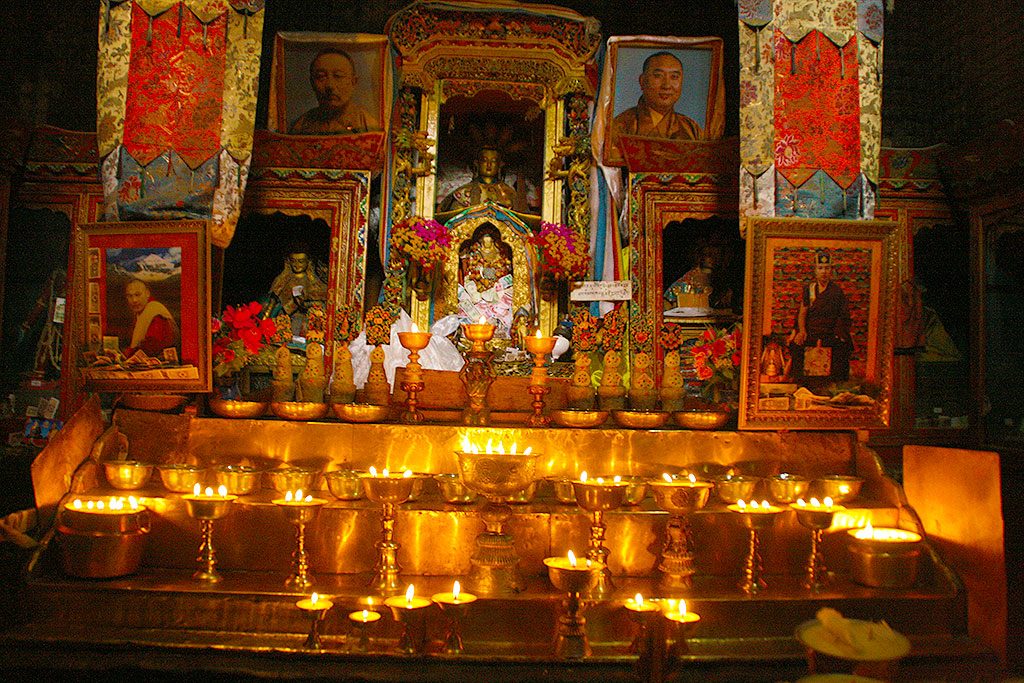
The talk among travellers in China in 2007 was that very soon foreigners wouldn’t need permits to travel around Tibet anymore; such was the optimism due to the up and coming Beijing Olympics in 2008.

Little did people know that within a few months, all the good intentions the Chinese authorities had about opening up Tibet would be shattered by the riots in Lhasa and Tibet closed to foreigners for quite a while. Even now (2019), Tibet is still nowhere near as open as it was back then in 2007.

About 20 kilometres before Shigatse, our van turned left off the main road and went onto a bumpy track full of potholes and puddles.

We passed sturdy farmhouses, some of them still under construction, and large fields full of grazing yaks. Wheat grew everywhere and the whole area looked quite prosperous.

The monastery of Shalu was the seat of the Bu tradition of Tibetan Buddhism, named after its founder Buton Rinchendrub, a famous 14th century scholar.

An earthquake in 1329 destroyed the original Shalu Monastery, However, Buton rebuilt the Monastery in 1333 under the patronage of the Chinese Mongolian emperor of the Yuan dynasty.

Many Han Chinese artisans and Newari artists from Nepal participated in its reconstruction giving it its distinctive architectural style exemplified by the green-tiled arched roof and steep eaves of the central hall, the Shalu Lakhang.

Apart from the architecture and the many large statues of important religious figures, what mostly grabbed our attention were the incredible murals.

Like in Samye, the tall walls that go behind the main altar are covered from top to bottom by amazing paintings, dimly lit by an occasional light bulb.

Apart from the usual, slightly repetitive, Buddha figures, there are many exquisite and exotic scenes of a non-spiritual nature, such as caravans of distinctly Arabic-looking merchants leading camels, slim Indian-looking courtiers at play, or beautiful young ladies.
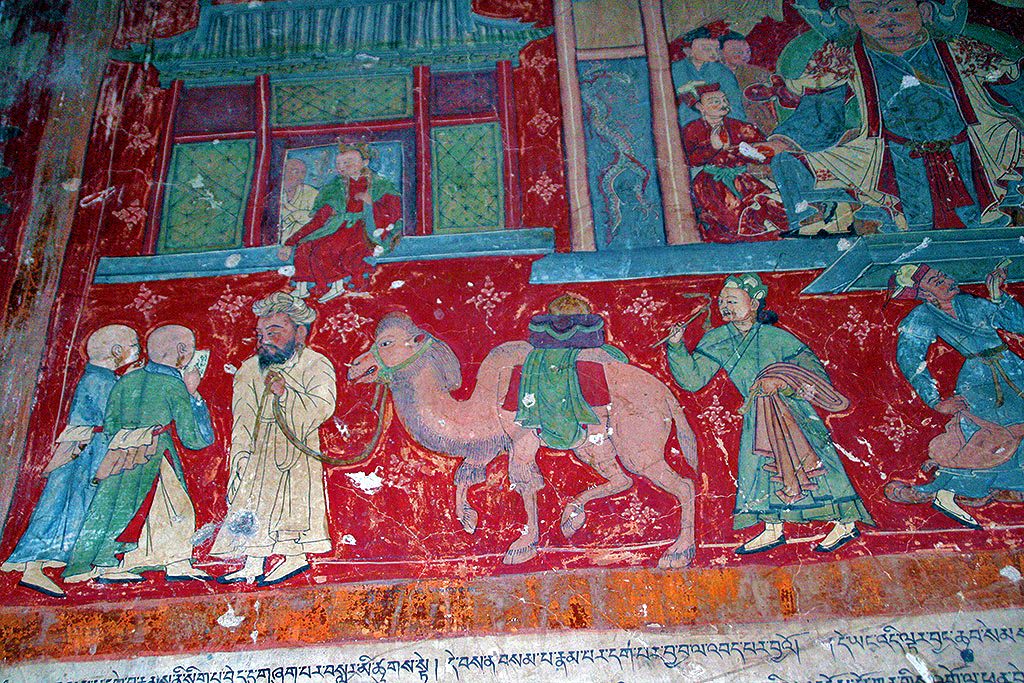
The murals in the side chapels, attributed to Nepali painters, mostly depict large elegant Buddhas in lotus position, demons and many-armed gods, surrounded by floral motifs. Given their shining state, they must have been retouched recently.

Not all the murals were so beneign. Gruesome scenes of animals and humans being flayed or disembowled also lined the walls.


During our exploration, friendly monks unlocked most of the smaller, side and upper storey chapels for us, allowing us to appreciate the treasures inside, such as ancient statues and thankas.

The sight of all these precious objects and paintings, clearly venerated by the monks, gave us a real sense of ancient history and tradition.

The monks lead us into the library which is normally kept firmly under lock and key. The collection of manuscripts and scrolls at Shalu is huge and very important for Tibetan Buddhism. Then, as we came out of the library we bumped into a young German who was staying at the monastery studying Buddhism and learning Tibetan. How on earth did he manage to get a permit to do that in Shalu?

Shalu village is completely traditional as well, it’s a warren of towering white-washed houses, protected by walls and intersected by narrow muddy lanes.

Interestingly, while we were exploring, the Shigatse – Shalu bus, an old battered vehicle, turned up, showing us that this is another excursion you could easily do on your own.

The Chinese Government began the restoration of Shalu Monastery in 2009, two years after we visited.
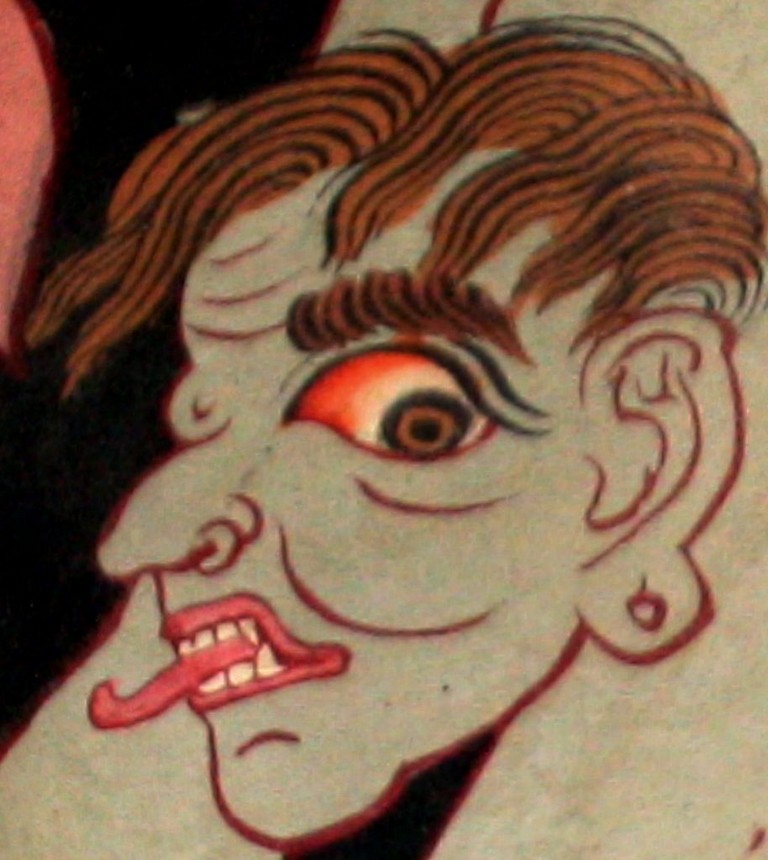
We had hired a Car and driver in Lhasa to go to Gyanste and Shigatse. Shalu Village lies somewhere between the two towns. As mentioned above, we saw local buses from Shigastse arrivng in Shalu. The only problem will be permits, and whether under stricter control the authorites will turn a blind eye to foreigners visiting Shalu.


The monks in Shalu told us that they had some guest rooms. However, we just visited on a day trip and stayed in Gyantse and Shigatse.

In Gyantse we stayed at the Jianzang hotel which lies on the main street of the modern part of town (Yingxiong Nanlu) and is certainly one of the nicest places we stayed at in the whole of Tibet, or even China. Embellished with bright, colourful murals and lovely potted plants and flowers, the hotel also has large, clean and comfy rooms. We paid 180 Yuan for a double with bathroom, though there were cheaper rooms and dorms as well. The hotel also has its own rooftop restaurant and staff are very friendly.

You will have no trouble finding several places to eat along the same main street. The Yak bar and restaurant, for which you have to go upstairs, is a pleasant, laid-back place with Tibetan sofas and low tables, specialising in western-style food such as chips, pizzas and burgers. We decided to give the guidebook-recommended Zhuang Yuan a miss after one look at their menu, outraged at the idea of paying nearly 30 Yuan for a portion of chips.

Instead, we walked into a large Chinese restaurant, a few doors away and identified by a green sign, where we had an excellent meal.

We stayed at the Shigatse Post Hotel, a new-ish place (2007) right opposite the posh Shigatse Hotel, down Shanghai Lu. Painted and furnished in Tibetan style our double room came complete with thankas and white ceremonial scarves, all very bright and clean; good value for 180 Yuan.

Going down Shanghai Lu towards the centre we found plenty of food, though restaurants were mostly of the simple, snack food variety. A ten-minute walk from the hotel will take you to the night market.
For more on Gyantse Click here: https://holachina.com/?p=10645
Samye to The Yumbulagang Palace: It’s a beautiful sunny autumn morning. We wake to the sounds of monks chanting and bells jingling in the faint breeze. We stumble out of our room and onto the roof top terrace of the Samye Monastery Hotel. The sunlight is blinding. We sit for a while, sipping hot tea, taking in the views over the monastery and postponing the packing for as long as possible.
We’d have loved to have spent another day, but eventually we peel ourselves away and go in search of a truck that will take us and the locals to the ferry quay to cross the Yalung Tsampa (the Brahmaputra River). Today we are heading to the Yumbulagang Palace.
The ride back to the quay is bumpy and uncomfortable. Margie, hemmed in between burly Tibetan peasant ladies and their bundles, is holding on for dear life and balancing precariously on the rim of the truck. The landscape is almost lunar.
Continue reading “Samye to The Yumbulagang Palace”